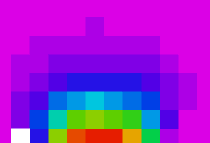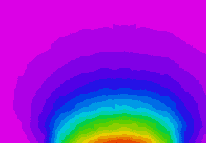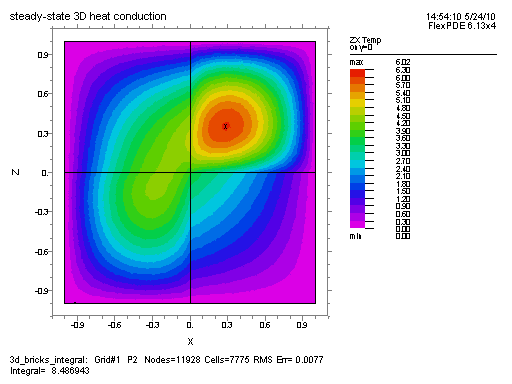Here is a little help on getting you started with this rendering. This may not be the best way to accomplish this task however, it should work.
First I created a structure to hold your data for parsing from text file:
public struct Data { public Data(float x, float y, float value){ X = x; Y = y; Value = value; } public float Value; public float X; public float Y; }
I then initialized the color palette based on your above image (reversed because I messed up the ordering initially):
Color[] Colors; private void InitColors() { Colors = new Color[20]; Colors [19] = new Color (230 / 255f, 29 / 255f, 0 / 255f, 1); Colors [18] = new Color (230 / 255f, 74 / 255f, 0 / 255f, 1); Colors [17] = new Color (230 / 255f, 119 / 255f, 0 / 255f, 1); Colors [16] = new Color (230 / 255f, 164 / 255f, 0 / 255f, 1); Colors [15] = new Color (230 / 255f, 207 / 255f, 0 / 255f, 1); Colors [14] = new Color (185 / 255f, 207 / 255f, 0 / 255f, 1); Colors [13] = new Color (140 / 255f, 207 / 255f, 0 / 255f, 1); Colors [12] = new Color (94 / 255f, 207 / 255f, 0 / 255f, 1); Colors [11] = new Color (49 / 255f, 207 / 255f, 23 / 255f, 1); Colors [10] = new Color (3 / 255f, 207 / 255f, 73 / 255f, 1); Colors [9] = new Color (0 / 255f, 207 / 255f, 173 / 255f, 1); Colors [8] = new Color (0 / 255f, 198 / 255f, 223 / 255f, 1); Colors [7] = new Color (0 / 255f, 153 / 255f, 230 / 255f, 1); Colors [6] = new Color (0 / 255f, 108 / 255f, 230 / 255f, 1); Colors [5] = new Color (0 / 255f, 63 / 255f, 230 / 255f, 1); Colors [4] = new Color (37 / 255f, 18 / 255f, 230 / 255f, 1); Colors [3] = new Color (82 / 255f, 0 / 255f, 230 / 255f, 1); Colors [2] = new Color (128 / 255f, 0 / 255f, 230 / 255f, 1); Colors [1] = new Color (173 / 255f, 0 / 255f, 230 / 255f, 1); Colors [0] = new Color (219 / 255f, 1 / 255f, 230 / 255f, 1); }
I then wrote a parsing function to get the data from your text file into memory, and analyze parts of the data for future use:
private HashSet<float> XValues; private HashSet<float> YValues; private List<Data> DataList; private float Min, MinX, MinY; private float Max, MaxX, MaxY; private void ParseData() { Min = float.MaxValue; Max = float.MinValue; MinX = float.MaxValue; MaxX = float.MinValue; MinY = float.MaxValue; MaxY = float.MinValue; DataList = new List<Data> (); XValues = new HashSet<float> (); YValues = new HashSet<float> (); if (File.Exists ("data.txt")) { StreamReader file = new StreamReader ("data.txt"); string line = ""; while ((line = file.ReadLine ()) != null) { line = line.Replace("(", string.Empty); line = line.Replace(")", string.Empty); line = line.Replace(":", ","); string[] split = line.Split (','); float x = System.Convert.ToSingle(split [0]); float y = System.Convert.ToSingle(split [1]); float value = System.Convert.ToSingle(split [2]); Data data = new Data (x, y, value); Min = Mathf.Min (Min, value); Max = Mathf.Max (Max, value); MinX = Mathf.Min (MinX, x); MaxX = Mathf.Max (MaxX, x); MinY = Mathf.Min (MinY, y); MaxY = Mathf.Max (MaxY, y); XValues.Add (x); YValues.Add (y); DataList.Add (data); } file.Close (); } }
Now it is easy to convert the parsed data into a Dataset that we can use:
private Data[,] Data; private void GenerateDataSet() { Data = new Data[XValues.Count, YValues.Count]; for (int x = 0; x < XValues.Count; x++) { for (int y = 0; y < YValues.Count; y++) { Data [x, y] = DataList [x + y * XValues.Count]; } } }
If we visualize this data now, we get the following:

In order to smooth this out, we are going to add values in between and interpolate based on the distance between known node values:
float[,] Interpolated; private void Interpolate() { int steps = 25; Interpolated = new float[Data.GetLength (0) * steps, Data.GetLength (1) * steps]; for (int y = 0; y < Interpolated.GetLength (1) - steps; y++) { for (int x = 0; x < Interpolated.GetLength (0) - steps; x++) { int x1 = x / steps; int x2 = x1 + 1; int y1 = y / steps; int y2 = y1 + 1; float distance1 = (new Vector2 (x, y) - new Vector2 (x1 * steps, y1 * steps)).magnitude; float distance2 = (new Vector2 (x, y) - new Vector2 (x1 * steps, y2 * steps)).magnitude; float distance3 = (new Vector2 (x, y) - new Vector2 (x2 * steps, y1 * steps)).magnitude; float distance4 = (new Vector2 (x, y) - new Vector2 (x2 * steps, y2 * steps)).magnitude; float value1 = Data [x1, y1].Value; float value2 = Data [x1, y2].Value; float value3 = Data [x2, y1].Value; float value4 = Data [x2, y2].Value; int totalCount = 0; int count = steps - (int)distance1; count = Mathf.Max (count, 0); float total = value1 * count; totalCount += count; count = steps - (int)distance2; count = Mathf.Max (count, 0); total += value2 * count; totalCount += count; count = steps - (int)distance3; count = Mathf.Max (count, 0); total += value3 * count; totalCount += count; count = steps - (int)distance4; count = Mathf.Max (count, 0); total += value4 * count; totalCount += count; total = total / (float)totalCount; Interpolated [x, y] = total; } } }
Now if we draw this interpolated data, we get something that looks a lot more like what you are trying to output. Here is the Texture generation code that was used:
public Texture2D GetHeatMapTexture() { int width = Interpolated.GetLength (0); int height = Interpolated.GetLength (1); var texture = new Texture2D (width, height); var pixels = new Color[width * height]; for (var x = 0; x < width; x++) { for (var y = 0; y < height; y++) { float value = Interpolated [x,y]; float normalized = (value - Min) / (Max - Min); normalized *= Colors.Length; int colorValue = (int)normalized; colorValue = Mathf.Clamp (colorValue, 0, 19); pixels [x + y * width] = Colors [colorValue]; } } texture.SetPixels(pixels); texture.wrapMode = TextureWrapMode.Clamp; texture.filterMode = FilterMode.Point; texture.Apply(); return texture; }
And here is what it looks like with your provided dataset:

There are probably better ways to accomplish this result, but at least this can provide you with a way to at least get started doing what it is you are trying to do.



